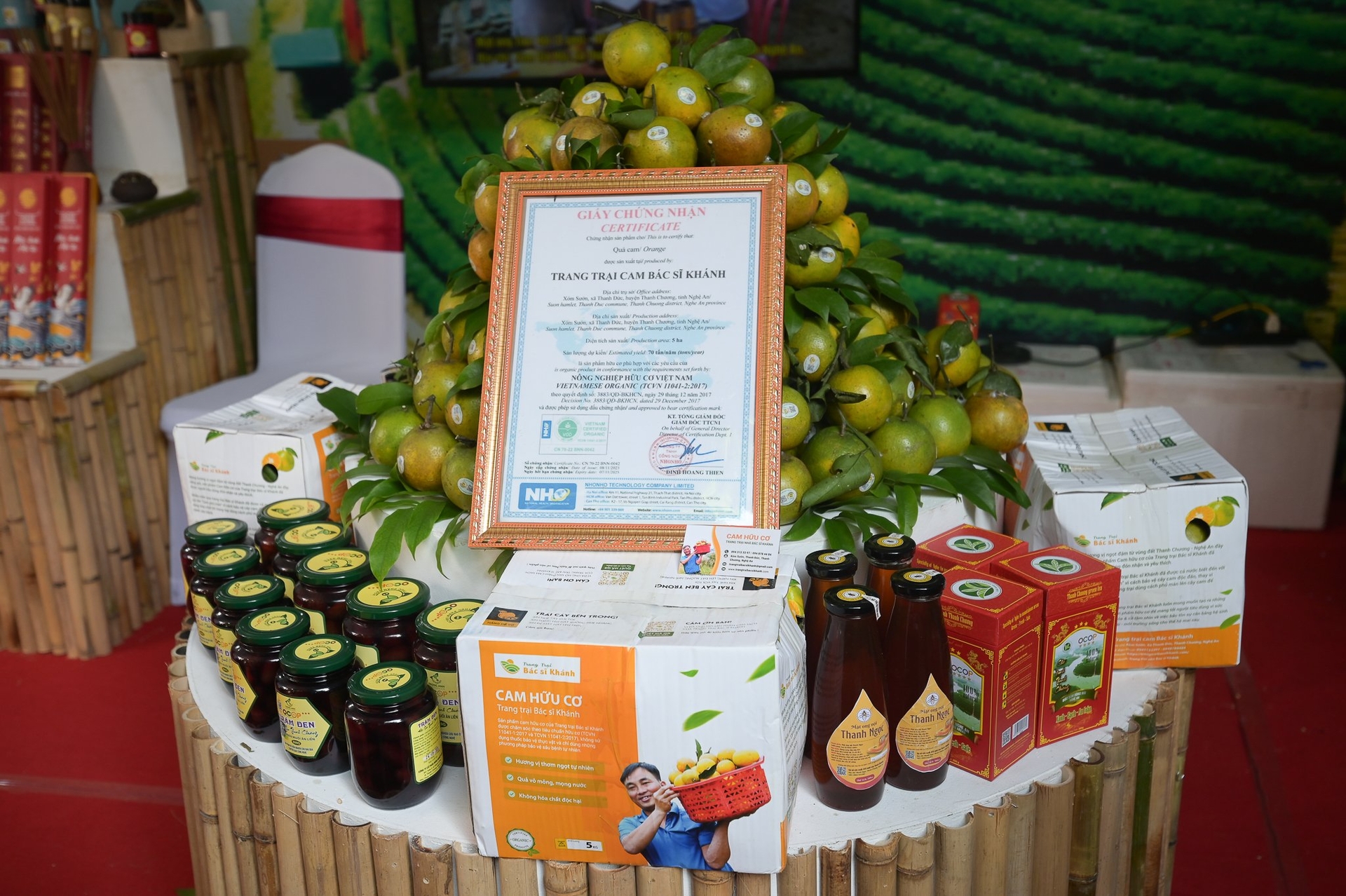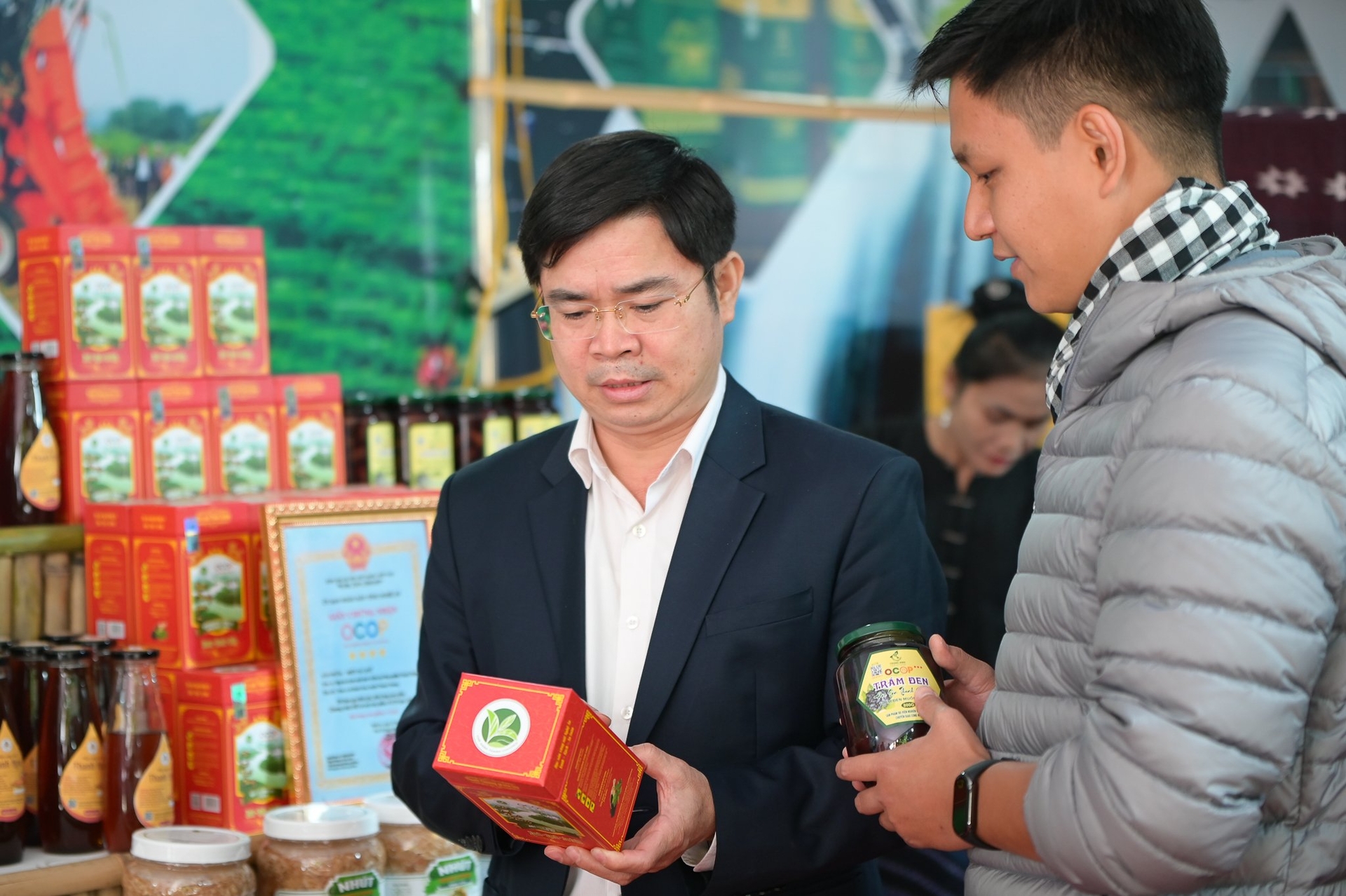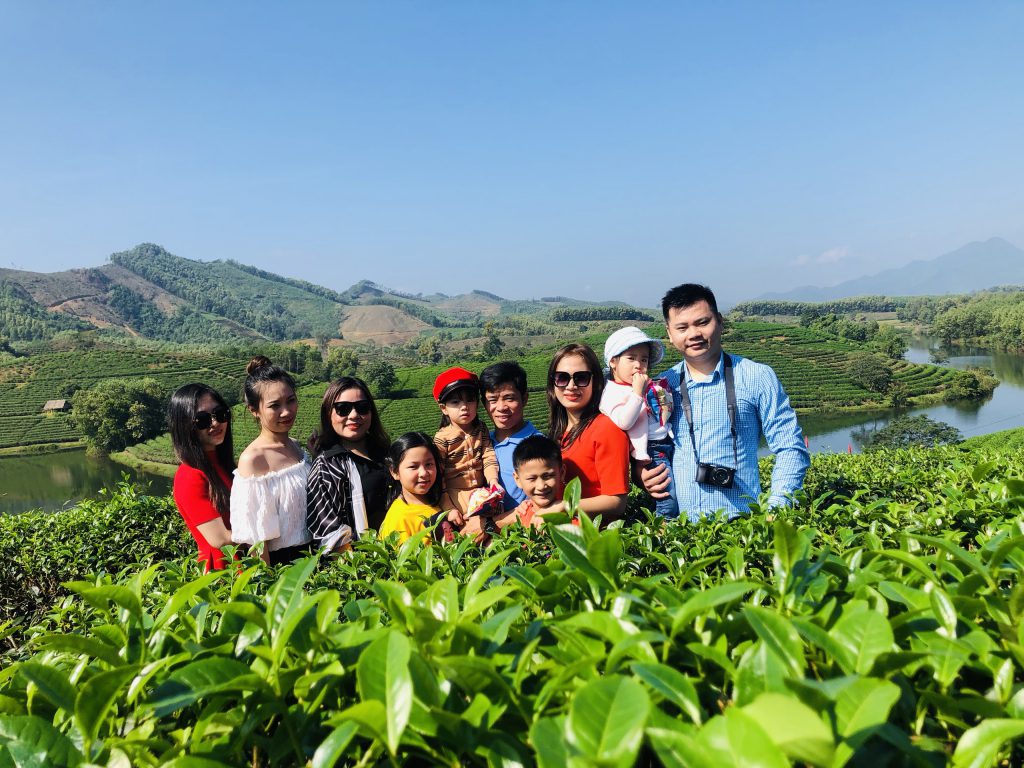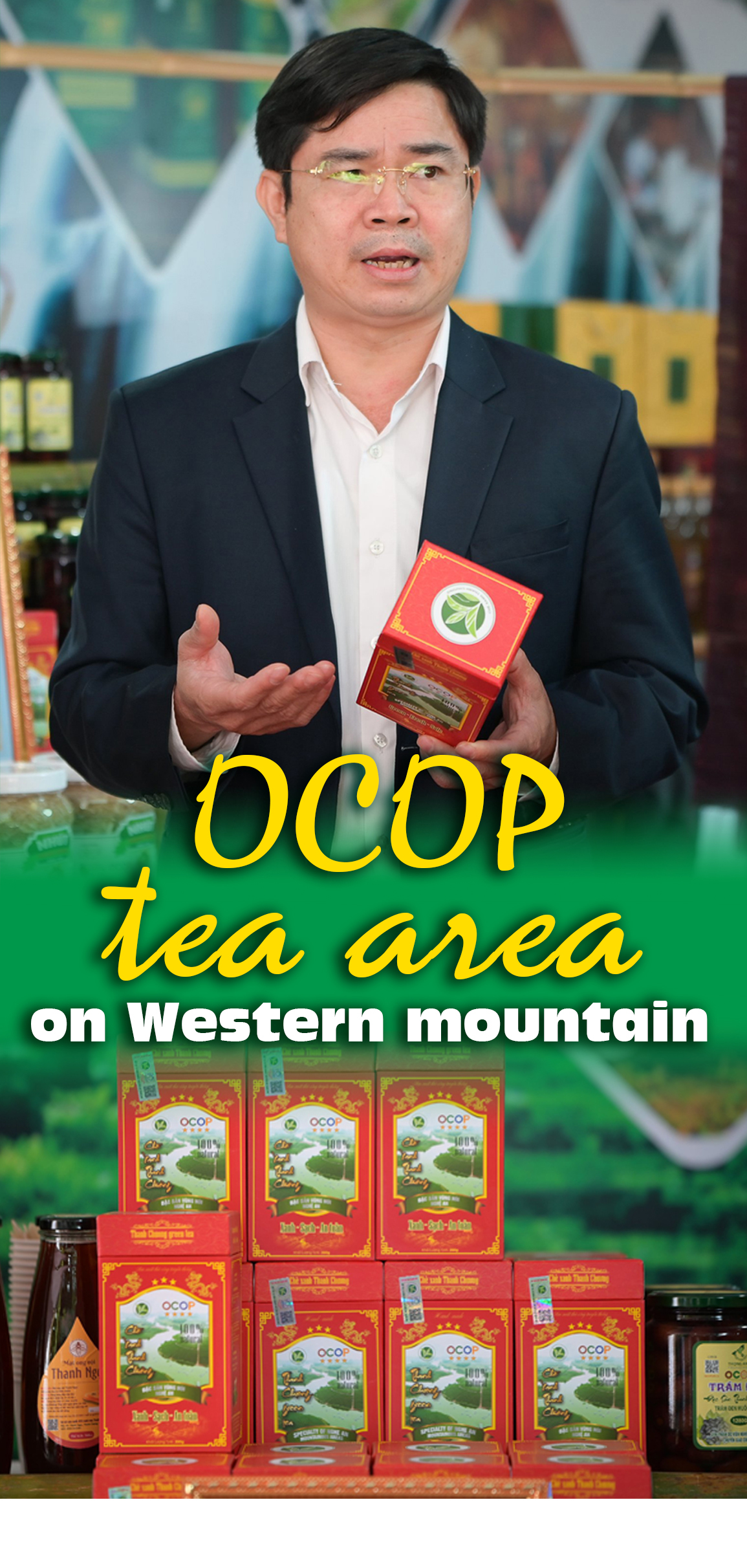Mentioning the West, surely in many people's minds, vast fields, straight from the wings of storks, and gardens ripe with fruit in Cuu Long land. Or indulge in cloud hunting in dewy breath, anchored on the majestic mountains of the Northwest. Otherwise, it is a strip of red basalt soil dotted with red dots of coffee harvest season. But there is still a very different "Western sky", wild and dreamy, like the invitation of the mountains and forests of the remote region.

In the midst of the sun that still falls in early winter at the Ministry of Agriculture and Rural Development headquarters, Thanh Chuong district's agricultural specialty display area is nestled close to building B6. A few simple bamboo and wooden shelves, some long, dark red silk sheets. Above are a lot of bamboo shoots, canariums and some other typical flavorings of the western mountainous district of Nghe An. If there were an additional sound of the trumpet or a tap of the feet dancing to the rhythm of the stalls, many people would feel like they were lost in a rural market somewhere.
The colorful freshness of the stalls, perhaps with the faded pink of peaches, the bright yellow of apricots, the orange of marigolds, or the odd shovel of small parallel sentences, the golden spikes as big as jackfruit seeds... perhaps it's enough to replace those Tet-smelling sounds.
But then a warm look like a ray of sunlight shining through the sea of floating clouds at the Muong Long heaven gate pulled us back to reality. Not wanting to capture everyone's imagination, it seemed like it took a few minutes for the man in his 40s to smile with his eyes and softly say: "This winter in the West is wonderful."

November is the time when the forests in the West change their leaves. If lucky, visitors can watch snowfall in the highland villages of Ky Son on the way to conquer the two majestic gates of heaven in this place. Especially around the end of December and beginning of January, the coldest time of winter, it is not difficult to see the whole sky and earth white in communes such as Tam Hop (Tuong Duong), Nam Can, Nam Can, Na Ngoi (Ky Son).
Not only does it have a European-like scenery, but the Western region of Nghe An also invites wood and welcomes it with colorful flowers. It could be the sunflower field in Nghia Dan, the yellow color dyeing the National Highway 7 on the Vietnam-Laos border with wild sunflowers, or the peach buds blooming early on the hillsides between the village's houses.
December is also the occasion for highland markets in Huoi Tu, Muong Long, or Nam Can border market (Ky Son), and Tam Thai market (Tuong Duong) to attract visitors from all over. Many unique products such as brocade, silverware, handmade souvenirs, or delicious charcoal-grilled dishes right at the market become an ideal destination for those who want to explore new cultural colors in the border region.
Perhaps because of the desire to recreate a countryside market in the heart of the Ministry of Agriculture and Rural Development, 11 districts and towns in Western Nghe An have brought all the most brilliant things of Thanh Chuong, Ky Son, Tuong Duong... to converge in this place. This. Standing in the middle of the booth, the man in his 40s was not in a hurry to answer. He pushed his glasses up the bridge of his nose and borrowed the story of his hometown's tea tree as an answer.


Born in Thanh Lien commune, Thanh Chuong district, Mr. Trinh Van Nha said that the more than 40 years he has experienced are equivalent to the time it took for the tea tree to take root in Thanh Chuong land. Remembering his childhood, he still remembers the image of his aunts and uncles, who were able to dispel hunger and poverty thanks to the tea tree.
The Chairman of Thanh Chuong District People's Committee confided that if they focus on investment and care in the first 3 years, tea growers can harvest and generate revenue from the fourth year onwards. The investment and fertilization effort is reduced, almost only weeding and fertilizing after a cycle of about 1 month/harvest. Many households in Thanh Chuong can achieve a yield of 5 quintals of fresh tea buds per acre of tea in one harvest. If picked 8-10 times a year, the output of one acre of tea can reach 4-5 tons. Even when the price drops to around VND 3.5-4 million/ton, one acre of tea can yield a harvest of VND 15 million/year. If the tea price reaches VND 5 million/ton, it can generate an income of VND 20-25 million.
That is a significant number for people in mountainous areas like Thanh Chuong, who previously only made friends with corn, cassava, peanuts, and potatoes. From the beginning, only a few households were doing the pilot model. In 2001, implementing the land conversion policy according to Directive No. 02-CT/TU of the Standing Committee of Nghe An Provincial Party Committee, many Thanh Chuong people boldly innovated.

When it comes to Thanh Chuong tea, perhaps Thanh Duc commune is among the key points. Chairman Nha said that hamlet 1 of Thanh Duc commune was formed based on several households from Nam Dan district and Cat Van commune, Thanh Chuong district who migrated to work in the new economy in the late 60s of the last century. Around the early 2000s, people here converted 40 hectares of fertile land and hill garden land to grow tea. This industrial tree has changed the appearance of border villages from the bare hills. Voices and laughter filled the neighborhood when up to 90% of households in the hamlet invested and developed tea trees, turning this species into a critical crop.
Many households in Thanh Duc commune have been attached to the tea tree from their grandfather's generation to their children's and grandchildren's generations, such as Mr. Tran Van Tue's family (Suon Hamlet), Mr. Nguyen Trong Thoai's family (Hamlet 1); Tran Van Giang, Phan Van Phu, Le Van Tinh (Chey Chuyen hamlet)... Some families grow tea on a large scale, with an area of up to 2-4 hectares. Not disappointing people, tea trees are deep-rooted, durable, and have few pests and diseases on Thanh Duc land.
Not satisfied with what they have, many households converted to tea cultivation according to VietGAP standards, helping to increase productivity control pesticide residues within the threshold and heavy metal residues at the allowable level.
In 2019, during the evaluation and classification of products participating in the "One Commune One Product (OCOP) Program" of Nghe An Provincial People's Committee, Thanh Chuong district had 7 "starred" products. Among the two 4-star products, Thanh Chuong green tea produced by Thanh Duc Agricultural and Tea Processing Cooperative stands out when perfecting product quality criteria, packaging, and labeling methodically.

Mr. Dang Duy Lam, Director of the Cooperative, said the cooperative's tea growing area is about 10 hectares, producing an annual output of about 10 tons of packaged finished products. According to the standard "1 shrimp, 2 leaves" (picking young tea buds, not harvesting by machine cutting), the cooperative's products are entirely harvested by hand. Up to now, the cooperative's green tea products have been supplied to many supermarket chains, stores, and retail markets within Nghe An and across the country. Product output is stable. The cooperative creates regular jobs for about ten local workers, with an average income of VND 6 million/person/month.
Despite being significantly affected by the COVID-19 pandemic in 2020 and 2021, after the 4-star OCOP tea product was recognized, Thanh Duc Agricultural and Tea Processing Cooperative persevered in the market and, at the same time, explored and researched the production of more diverse products, aiming at refined processing to serve consumer tastes.
From the tea tree, the People's Committee of Thanh Chuong district continues to direct and help people develop the production of traditional products and services with advantages that meet standards and are competitive in the market while promoting the national OCOP program. Initial statistics show that after about 5 years of implementation, 38 communes and towns in the district have invested and have typical local products, with nearly 700 model gardens and more than 40 new rural gardens, about 30 professional associations and more than 500 farms and ranches. Thanks to the synchronous and robust development of essential plants and animals, Thanh Chuong district now has more than 40 agricultural cooperatives. Some cooperatives have formed and built chain links in production, product processing and consumption. Many economic models earn billions of dong each year, and farms and ranches attract and create jobs for thousands of local workers.
The district government is committed to promoting trade, introducing and bringing OCOP products to the electronic trading floor, and connecting to retail solid chains nationwide, with immediate priority given to the 4-star OCOP product group of Thanh Chuong.

The OCOP program not only contributes to changing the agricultural sector in the direction of reducing the proportion of ineffective short-term crops, increasing the area of industrial crops, fruit trees and developing commodity livestock, developing forms of Production organization associated with production links and quality management but also helps rural people raise awareness of local potential.
According to Mr. Trinh Van Nha, Thanh Chuong district now has many "multi-value integration" models in the agricultural industry, such as experiential tourism, community tourism, and farming tourism.
Among them, it is impossible not to mention the Thanh Chuong tea area, with a total area of about 80 hectares. Located in Thanh An commune, this place has jade green terraced tea islands. Cau Cau dam surrounds the tea hills, making them look from afar like giant snails, showing off their beauty on the water's surface. A unique feature is that the tea hills and tea islands in Thanh Chuong are almost present and beautiful all year round, not depending as much on the season as other tourist destinations.
With dozens of different tea oases, each island has an area of more than 1 hectare. Visitors can enjoy relaxation and an incredibly fresh atmosphere when sitting on a small boat, weaving through each green oasis. Faintly in the space is the gentle scent of tea. In particular, each oasis also has a small hut. Inside, people have set up tables and chairs, including a kettle with mixed water, so that people traveling to Thanh Chuong tea hill can sit and rest. The poetic natural scenery is like a song: "The road to Nghe An is all around/ The green mountains and water are as clear as a painting."

Thanh Chuong tea area is most beautiful in the early morning when it is still dew. Visitors can start a new day full of energy with the aroma of tea and a cool, fresh climate that is no different from the scenery in other famous tea-growing locations in Moc Chau (Son La), Thai Nguyen, or Bao Loc (Lam Dong).
Tea trees are increasingly green, just like the wishes of Thanh Chuong district in the trend of developing agriculture associated with processing and promoting tourism. There was a time when it encountered barriers in infrastructure and transportation due to its remote location in the West. Still, Thanh Chuong will likely rise in the upcoming time when the Hanoi - Vientiane expressway passes through the district and the highway from Thanh Thuy border gate to Vinh City, connecting to the North-South expressway, is completed.
In the short term, Thanh Chuong district will take full advantage of its geographical location near the Ho Chi Minh Highway, with a total length of more than 53km. Along this route, there is a vast forest reserve and area up to 64,000 hectares, including more than 22,000 hectares of planted forests. This road is also the main traffic route, bringing visitors from Hanoi and Ho Chi Minh City to the Thanh Chuong tea island area.
"Thanh Chuong in particular and Western Nghe An in general still have difficulties, but there are also many opportunities if they develop in the right direction," Chairman Trinh Van Nha confided.


The dreams of building Thanh Chuong are still in the future. Mr. Nha looks directly at this reality and admits that up to now, the district has not attracted many large and key projects into the area. Besides, agricultural production is still small and fragmented, not creating many commodity products. The district's budget revenue scale is still limited, and state management in some areas is not strict.
In the medium term 2021-2026, the district government is determined to implement 5 key programs and 3 breakthroughs outlined by the Resolution of the 31st District Party Congress. In addition, Thanh Chuong affirmed that he will pay special attention to planning work, especially integrating and linking with the provincial planning for 2021-2030, vision 2050, including the development planning for Dung town. In addition, there is planning for 5 industrial clusters and 2 industrial parks, including Thanh Thuy border gate industrial park, serving the development task based on main traffic corridors, which in the near future will be high-speed Hanoi - Vientiane Express.

Regarding economic development, three main issues were also identified by the District People's Committee, which are investing in transport infrastructure, exploiting tourism potential, and developing agricultural strengths towards high technology. These are the inseparable pillars in Thanh Chuong's development. At the same time, the district will build brands for well-known products, and find suitable output markets for the products, especially tea trees. Coordinating with the Ministry of Agriculture and Rural Development to implement a program to connect, display and promote products is also included because it will promote Western Nghe An in general and Thanh Chuong in particular. reach more consumers. From there, people across the country will feel the quality of the district's OCOP products and become regular customers.
Currently, Thanh Chuong district has issued a tourism development program in the district with a vision to 2030 and is implementing it. In particular, investing in developing tourism infrastructure, tourism products and especially people working in tourism helps the community change awareness and participate with businesses in tourism development, helping to improve living standards and economic development. Along with that, the district will connect with other tourist destinations of the province, such as Uncle Ho's Hometown, Truong Bon, Cua Lo or Vinh City.
"When people see legitimate benefits from agriculture, they will stick with it. To do that, there must be a connection between the State, farmers, scientists, and businesses, focusing on strong products," Chairman Trinh Van Nha thought.




